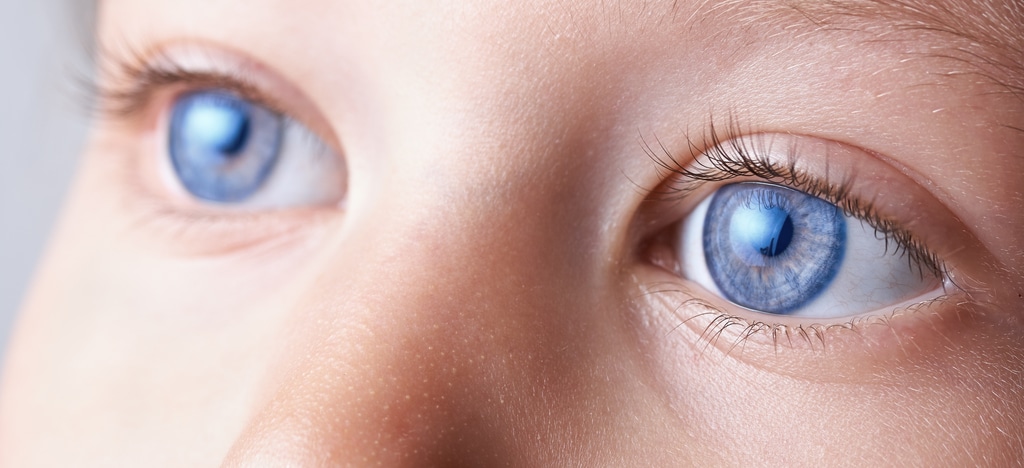What can my baby see during the first year of life?
A baby’s vision develops quickly during the first year of life. It helps new parents understand their newborns better if they have an idea of what babies can see.
- Newborns: can see large shapes and faces, as well as bright colors.
- By 3 to 4 months: most babies can focus on a variety of smaller objects and tell the difference between colors (especially red and green).
- By 4 months: a baby’s eyes should be working together. This is when babies begin to develop depth perception (binocular vision).
- By 12 months: a child’s vision reaches normal adult levels while he continues to learn about and understand what he sees.
What will be the color of my child’s eyes?
New parents often ask what color I think the baby’s eyes are going to be and I tell them we have to wait until their first birthday to be able to tell that! When we are talking about eye color, we’re really talking about the appearance of the iris, the muscular ring around the pupil that controls how much light enters the eye. After all, the pupil will always be black, iris color, just like hair and skin color, depends on a protein called melanin which is secreted by specialized cells in our bodies called melanocytes .
Over time, if melanocytes only secrete a little melanin, your baby will have blue eyes. If they secrete a bit more, his eyes will look green or hazel. When melanocytes get really busy, eyes look brown (the most common eye color), and in some cases they may appear very dark brown. .
Because it takes about a year for melanocytes to finish their work, we can only be certain of the eye color by one year of age.
Why is my child Cross-Eyed?
Parents also often note that their newborns’ eyes appear to cross from time to time. It is quite normal during the first 6 months of life.
- For the first 2 to 4 weeks of life as vision is not accurate enough parents may feel like their newborns are looking past them rather than at them, and that is normal. By the fourth week of life, however, your baby will focus on your face if you’re cradling him.
- By 2 months you may notice your infant will follow your face or a toy a little way, then lose it as it crosses from one side to the other.
- By 3-4 months, however, he should be able to track from right to left and back again.
- By 6 months of age the eyes should continue looking in the same direction even if one of them is covered temporarily. If you ever notice that your 6-month-old or older child has an eye that doesn’t always look the same way as its partner, alert his doctor..
What are warning signs of a vision problem?
- Babies up to 1 year of age:
Babies older than 3 months should be able to follow or track an object, like a toy or ball, with their eyes as it moves across their field of vision. If your baby can’t make steady eye contact by this time or seems unable to see, let your child’s doctor know.
Before 4 months, most babies’ eyes occasionally look misaligned (strabismus). However, after 4 months, inward crossing or outward drifting that occurs regularly is usually abnormal. If one of these is present, let your child’s doctor know.
- Preschool age:
If your child’s eyes become misaligned, let your child’s doctor know right away. However, vision problems such as a lazy eye (amblyopia) may have no warning signs, and your child may not report vision problems. That is why it’s important at this time to have your child’s vision checked. There are special tests to check your child’s vision even if he cannot yet read.
- All children:
- If you notice any of the following signs or symptoms, let your child’s doctor know:
- Eyes that are misaligned (look crossed, turn out, or don’t focus together)
- White or grayish white color in the pupil
- Eyes that flutter quickly from side to side or up and down
- Eye pain, itchiness, or discomfort reported by your child.
- Redness in either eye that doesn’t go away in a few days
- Pus or crust in either eye
- Eyes that are always watery
- Drooping eyelids
- Eyes that often appear overly sensitive to light
Keep in mind that each child’s vision develops at his or her own rate, but the overall pattern of development is the same. Because a baby’s vision develops quickly during the first year of life, your child’s doctor will check your baby’s eyes at each well-child visit.
Even after the first year, regular eye exams by your child’s doctor are important to identify problems that may arise later in childhood. I always tell my patients that problems that are found early have a better chance of being treated successfully.





































